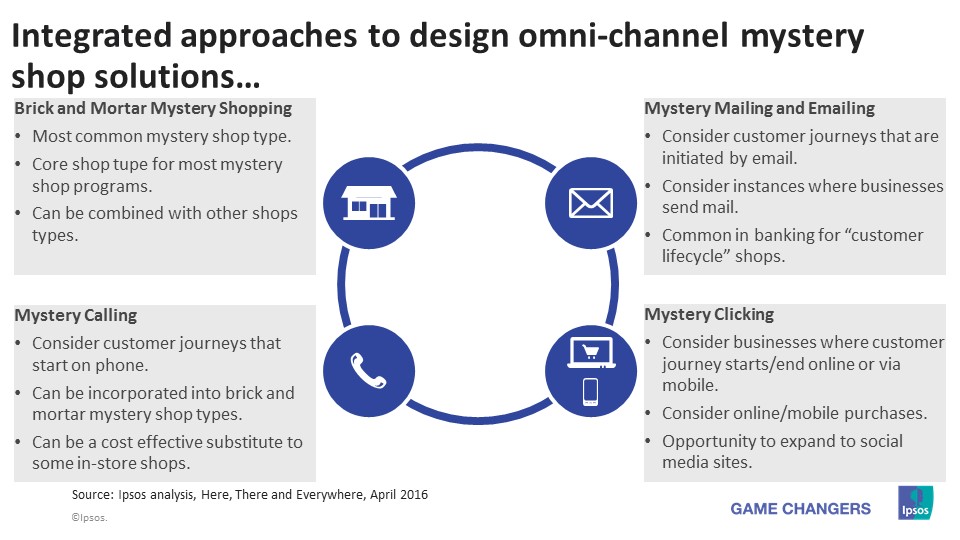The Importance of Mystery Shopping in an Omni-Channel Retail World
Today, brands can no longer afford to interact with customers in silos, treating each customer channel as a singular and separate touchpoint. On the contrary, success in today’s interconnected, omni-channel retail world means interacting with, and serving customer seamlessly, wherever they are, on whatever device they may be using.
To illustrate this point, today 81% of consumers conduct online research before making a purchasing decision. Research conducted on behalf of Google by Ipsos MediaCT shows that 71% of in-store shoppers who use smartphones for research say their device has become more important to their in-store experience and 43% of shoppers that can’t find what they are looking for in-store leave frustrated (often to purchase from an online competitor like Amazon).
And the stakes of having, and getting an omni-channel retail strategy right, are paramount. Forrester Research predicted that U.S. online retail exceeded $325 billion in sales in 2015, with web-influenced in-store sales totaling more than $1.4 trillion. Furthermore, shoppers who buy from a business both in-store and online have a 30% higher lifetime value than those who shop using only one channel.
As brands develop an infrastructure to serve the omni-channel shopper, they must also ensure they invest in mechanisms to confirm their intended customer experience is consistently happening across their various customer touchpoints. Because as we know, in the age of customer-centricity, consistently executing and delivering on your brand promise is one of—if not the—single most critical element to creating a sustainable competitive advantage.
As a global leader in mystery shopping, Ipsos designs mystery shopping solutions with the omni-channel retail world in mind. In the highly social, connected world we live in today, it would be a mistake to only measure compliance for walk-in customers at brick and mortar locations.
Today, customers interact with your brand across a variety of mediums. Capabilities exist to take an omni-channel approach to mystery shopping by measuring interactions across all of your customer touchpoints—including contact centers, online, via mobile and through social media.
Ipsos’ Omni-channel Mystery Shopping Solutions include:
Online and Mobile Shops:
- Digital mystery shops conducted via a brand’s website or mobile application
- Retailers, restaurants, banks, hotels, automotive dealerships, B2B
- Customer Experience, Checkout, Fulfillment, Support/Chat
Mail and Email Shops:
- Mystery mail and emails, sent or received, to a brand’s physical locations or contact centers
- Banks, automotive dealerships, mail carriers, retailers, restaurants, B2B
- Traditional (written) or video shops
Telephone Shops:
- Mystery calls to a brand’s physical locations or contact centers
- Retailers, restaurants, banks, hotels, automotive dealerships, B2B
- Traditional (written) or audio recorded shops
Brick and Mortar Shops:
- In-store mystery shops at a brand’s physical locations/outlets
- Retailers, restaurants, banks, hotels, automotive dealerships, etc.
- Traditional (written) or video shops
It is important to note that the best brands utilize an integrated approach to designing omni-channel mystery shop solutions by combining different shop types into one singular customer journey. For example, as opposed to having a separate mystery shopper conduct a telephone and brick and mortar shop to measure compliance to brand standards in a silo, opportunity exists to combine these shop types under one common scenario conducted by the same shopper. In this instance, the same shopper might call a location in advance to speak to an associate and schedule an appointment and then visit the physical location to make observations around the customer experience.

Brick and Mortar Mystery Shopping
- Most common mystery shop type.
- Core shop type for most mystery shop programs.
- Can be combined with other shops types.
Mystery Mailing and Emailing
- Consider customer journeys that are initiated by email.
- Consider instances where businesses send mail.
- Common in banking for “customer lifecycle” shops.
Mystery Calling
- Consider customer journeys that start on phone.
- Can be incorporated into brick and mortar shop types.
- Can be a cost-effective substitute to some in-store shops.
Mystery Clicking
- Consider businesses where customer journey starts/end online or via mobile.
- Consider online/mobile purchases.
- Opportunity to expand to social media sites.
Conclusion
In summary, failing to leverage an omni-channel approach to mystery shopping represents a dangerous “blind spot” that could have costly ramifications for your organization—particularly as it relates to reducing customer churn and increasing conversion, satisfaction, sales and lifetime customer value.






![[LinkedIn Live] Ipsos Global Trends: The Workplace Edition](/sites/default/files/styles/list_item_image/public/ct/event/2024-11/ipsos-global-trends-workplace-edition-thumb.jpg?itok=wucV_Pn4)